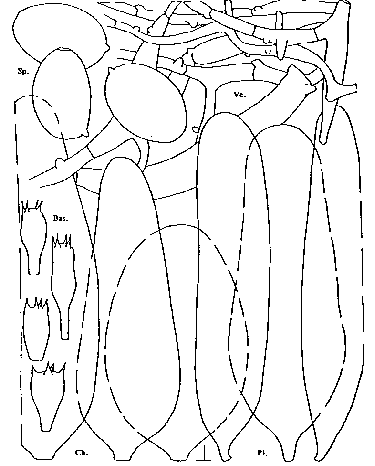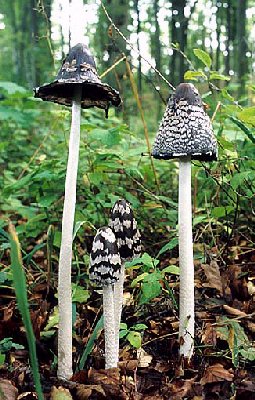Macroscopic features |
Pileus 20-70 x 15-40 mm when still closed, ellipsoid or ovoid, first covered with whitish, soon pale greyish or beige, cream-beige, later beige, greyish ochre or ochre-brown veil, breaking up in patches. Lamellae very crowded, free, first whitish, then brownish, later grey-brown to dark grey, finally black. Stipe up to 300 x 6-15 mm, slightly attenuate upwards, white or grey-white, minute woolly fibrous, in particular at base. |
Microscopic features |
Spores [120,6,4] 14.0-18.8 x 9.6-13.0 µm, ellipsoid or ovoid, rounded at apex, very dark brown, almost black, with central, c. 2.5 µm wide germ pore; Q = 1.25-1.60, av. Q = 1.35-1.50; av. L = 14.7-16.9, av. B = 10.7-11.6 µm. Basidia 16-46 x 12-15 µm, 4-spored, surrounded by 5-8 pseudoparaphyses. Pleurocystidia 100-165 x 28-50(-60) µm, utriform, cylindrical, conical or ellipsoid. Cheilocystidia 80-150 x 24-50 µm, utriform, broadly utriform, ellipsoid or conical. Elements of veil thin-walled, diverticulate, up to c. 100(-175) x (3-)5-14(-18) µm. Clamp-connections present. |
Habitat & distribution |
Solitary or a few together, on calcareous soil or chalky loam, mainly in Fagus forests. Rare but widespread in Europe. In the Netherlands only known from the valley of the river IJssel. |
Remarks |
The very large spores with a breadth of 10-13 µm in addition to the habitat not on dung are the salient features of Coprinus picaceus. All species in subsect. Alachuani, except for Coprinus picaceus and C. sclerotiorum (growing on sclerotia in dung), have spores whose breadth is always less than 10 µm. The macroscopically similar Coprinus stanglianus and C. kimurae can readily be distinguished on spore size. |

[Copyright © by ]

[Copyright © by Hans Bender jbe8995374@aol.com]